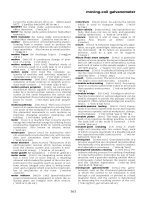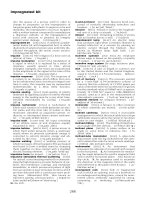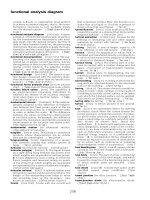Handbook of Lubrication Episode 2 Part 6 pps
Bạn đang xem bản rút gọn của tài liệu. Xem và tải ngay bản đầy đủ của tài liệu tại đây (5.65 MB, 16 trang )
FIGURE 2. Section through babbitt thickness showing advanced stage of fatigue cracking in babbitt with cracks
extending to bond and intersecting. (Magnification × 75.) (From Burgess, P. B., Lubr. Eng., 9(6), 309, 1953.
With permission.)
478 CRC Handbook of Lubrication
FIGURE 1. The effect of lining thickness on babbitt fatigue strength.
(From Szeri, A. Z., Ed., Tribology: Friction, Lubrication, and Wear,
Hemisphere Publishing, Washington, D.C., 1980. With permission.)
Copyright © 1983 CRC Press LLC
machinery in which the bearings are used and is in the form of weld spatter, grinding wheel
abrasive, and foundry sand. Other debris can enter the bearing from the environment.
3
Regardless of the source, the debris can cause scoring and tracking of the bearing surface
and embedding of the debris in the surface. Journal scoring can also occur, but its severity
is dependent upon the relative hardness of the debris and journal materials. In some cases
the debris becomes completely embedded in the bearing material and results in only super-
ficial wear damage with no significant effect on bearing performance. In other cases, severe
wear damages both the bearing and journal. Increased wear and ultimate failure of the
bearing occurs. Figure 5 shows circumferential scoring, tracking, and embedded debris in
a 76-mm (3-in.) diameter tin-base babbitt bearing with an embedded debris particle at the
end of a score mark.
Self-propagating mechanical wear by debris can also occur. One such type of wear has
Volume II479
FIGURE 3.Sketch showing babbitt fatigue initating wiping damage.
FIGURE 4. Babbitt fatigue in 178-mm (7-in.) diameter turbine bearing
with thick babbitt layer.
1,2
Copyright © 1983 CRC Press LLC
been termed wire-wooling or machining-type wear because the debris generated resembles
wire wool or metal turnings by a machine tool.
4,5
In this type of wear the journal is usually
more severely worn than the bearing. Severity of the damage is dependent upon the chromium
content of the journal steel. High chromium, e.g., 12% chromium, is particularly susceptible
to this type of wear damage as seen in Figure 6. Figure 7 is the mating bearing which was
used. The damage is initiated by debris embedded in the bearing material which generates
additional journal steel debris and forms a hard steel scab in the babbitt surface. This scab
acts as a tool which further propagates the wear and often results in catastrophic damage.
Simple scoring damage on a journal can sometimes be incorrectly identified as wire-wooling
or machining-type wear, but in many cases is not self-propagating.
Another type of mechanical wear results from self-loading or radial binding of a bearing
and its journal. Jamming of debris in the bearing clearance, too tight a radial fit, or dimen-
sional interference from differential thermal expansion
6
can cause high wear of both bearing
and journal. Figures 8 and 9 show a graphite bearing and its journal which were worn by
self-loading. Both axial and circumferential cracks occurred in the graphite bearing.
Electrical Damage
Wear is sometimes experienced in rotating machinery as a result of the passage of current
between the bearing and its mating surface, journal, or thrust runner.
7,8
Sparking between
the surfaces causes pitting damage to both surfaces. Pits on the harder journal or runner
surfaces are usually considerably smaller than those on the bearing. Multiple pits, closely
spaced, produce a frosted appearance of the surfaces; and the removal of fused metal particles
cause the surfaces to be rough. The rough surfaces produce further wear by mechanical
abrasion. An additional consequence of sparking is deterioration of the lubricant and possible
contamination of the lubricant and the lubricating system by spark debris. In extreme cases,
the passage of current can cause an increase in the temperature of the parts which may
damage the bearing or the lubricant.
Volume II481
FIGURE 7.Damaged babbitt bearing used with journal of Figure 6.
1,2
Copyright © 1983 CRC Press LLC
Regardless of their size, electrical pits have a characteristic appearance. The bottoms are
rounded and have a smooth, shiny, melted appearance (Figure 10). Usually the periphery
of the pit at the bearing surface has a ridge of melted metal. In some cases this ridge is
worn away by contact with the journal. For cases in which wiping damage has been su-
perimposed, electrical pitting can be identified as the cause by examining the harder journal
surface which operated against the bearing.
Volume II 483
FIGURE 10. Electrical pitting in tin-base babbitt produced by
high current. (Magnification × 15.) (From Boyd, J. and Kaufman.
H. N., Lubr. Eng., 15(1), 28, 1959. With permission.)
FIGURE 11. Electrical pitting in tin-base babbitt produced by
low current. (Magnification × 15.) (From Boyd, J. and Kaufman,
H. N., Lubr. Eng., 5(1), 28, 1959. With permission.)
Copyright © 1983 CRC Press LLC
Figure 12 shows schematically some sources of bearing currents in rotating machinery.
Table 1 reviews these sources and methods of eliminating or reducing the bearing currents.
Because bearing currents may be produced by a variety of conditions, no single method of
measuring potentials is suitable in all cases. Table 1 indicates the best location for taking
measurements. In the case of the dissymmetry effect, measuring the potential between the
shaft and one bearing may be unreliable. This is because both bearings are in series with
the generated emf and a temporary large resistance in the one bearing may make the potential
across the other bearing negligible. The most reliable method is to measure the potential
between the extremities of the shaft. Using this method on ordinary electrical apparatus with
484CRC Handbook of Lubrication
FIGURE 12.Principal sources of bearing current in rotating machinery. (From Boyd, J. and Kaufman, H. N.,
Lubr. Eng., 15(1), 28, 1959. With permission.)
Copyright © 1983 CRC Press LLC
486 CRC Handbook of Lubrication
Table 1 (continued)
PRINCIPAL SOURCES OF BEARING CURRENT AND METHODS OF CURRENT CONTROL
a
See Figure 12.
Copyright © 1983 CRC Press LLC
journal bearings, it was found that potentials less than 300 mV cause no significant electrical
damage. The corresponding value for machines with ball and roller bearings is 100 mV.
Since electrostatic effects are greatly influenced by humidity and by surface conditions,
the measurement of electrostatic potential is apt to be extremely erratic. Absence of elec-
trostatic potential during a set of measurements does not necessarily mean that such potentials
are not present under other conditions. Generally speaking, electrostatic potentials ordinarily
do not produce sustained currents of large magnitude. The intermittent charging and dis-
charging, however, can eventually produce enough bearing damage to cause failure.
The erratic nature of electrostatic potentials makes it difficult to set practical limits for
satisfactory operation. It is known that peak voltages of 20 V or more can produce bearing
damage. Reducing the voltage to the order of 1 V by some form of grounding device
ordinarily eliminates the trouble.
The main methods of eliminating or reducing damage due to bearing currents include: (1)
eliminating the source, (2) insulating the machine parts, (3) grounding the shaft, and (4)
modifying the machine design.
Damage from Thermal Effects
The physical properties of some materials, such as the tin-base babbitts can differ along
different axes of the grains making up their structure. Such anisotropic properties, coupled
with differences in orientation of grain axes, can result in grain distortion when thermal
cycling is imposed. This effect is shown schematically in Figure 13. If this grain distortion
occurs in a babbitt bearing, the journal can contact the distorted or raised grains and result
in slight wear or burnishing. This produces a mottled appearance of the bearing surface as
shown in Figure 14. Mottling is usually not detrimental to bearing performance. However,
Volume II 487
FIGURE 13. Sketch showing effect of thermal cycling on tin-base babbitt grains.
1,2
FIGURE 14. Surface mottling on 178-mm (7-in.) diameter bearing due to anisotropy of tin-base
babbitt.
1,2
Copyright © 1983 CRC Press LLC
in some cases of severe grain distortion, cracks can occur in the babbitt surface along the
grain boundaries as fatigue from thermal cycling.
Another thermal phenomenon results from the reduced strength properties of babbitt with
increasing temperature. At elevated temperatures babbitt will undergo creep with rippling
of the surface and subsequent wiping.
9
WIPING
Wiping is the smearing or removal of bearing material from one point and the redeposition
at another point on two surfaces in sliding contact. Superficial wiping in which bearing
performance is not significantly affected can occur from either a temporary overload or
temporary loss of lubricant. If either the overload or loss of lubricant is of long duration,
severe damage frequently results. Bearing misalignment often results in wiping damage.
Wiping damage is shown in Figure 15 on a 178-mm (7-in.). diameter bearing. Babbitt
smeared by wiping is shown in the developed view of Figure 16.
488 CRC Handbook of Lubrication
FIGURE 15. Wiping damage on a 178-mm (7-in.) diameter bearing.
FIGURE 16. Developed view of babbitt smeared by wiping.
1,2
Copyright © 1983 CRC Press LLC
Wiping sometimes is the indirect result of blistering at the interface of babbitt metal
bonded to steel. This is a rare occurrence caused by hydrogen gas, trapped in the steel during
manufacture, later diffusing to the interface where sufficient pressure is developed to cause
the babbitt to blister and to be wiped by the journal or runner. Figure 17 is a section through
babbitted steel which shows the inclusions in steel through which the gas can migrate to
cause a blister. Figure 18 is a section through a blister showing the separation at the bond.
Volume II489
FIGURE 17. Section through babbitted steel showing babbitt blister formation at locations
above inclusions in steel.
Copyright © 1983 CRC Press LLC
shows leaded bronze corrosion combined with fatigue on a 229-mm (9-in.) diameter railroad
diesel bearing. Figure 21 shows a metallographic section through a copper-lead bearing in
which lead corrosion occurred. The black voids at the bearing surface were pockets of lead
removed by the corrosive attack. Figure 22 is a metallographic section showing copper
corrosion in a copper-lead bearing. The white copper grains at the bearing surface have been
chemically attacked.
Volume II491
FIGURE 20. Corrosion and fatigue of a leaded-
bronze railroad diesel bearing.
1,2
FIGURE 21. Section through a copper-lead bearing showing lead corrosion. (Magnification × 150.) (From
Burgess, P. B., Lubr. Eng., 9(6), 309, 1953. With permission.)
Copyright © 1983 CRC Press LLC
EROSION
Erosion is the removal of material from the bearing surface by fluid action which results
in the formation of voids or pits in the surface. It can be produced by changes in the direction
of flow of high-velocity fluid streams or by the abrasive action of debris in the fluid stream
as it impinges on the bearing material.
Cavitation erosion is a type of erosion in which the formation and collapse of gas bubbles
in the lubricant produces high localized pressures which result in fatigue pitting of the bearing
surface. Figure 25 shows erosion damage on a 44-mm (1.15 in.) diameter aluminum bearing
from a high-speed gas compressor. Figure 26 is an enlargement of the damage.
Volume II493
FIGURE 24. Enlargement of fretting corrosion of bronze bushing
of Figure 23. (Magnification × 15.)
1,2
FIGURE 25. Cavitation erosion of a 44-mm (1.75-
in.) diameter aluminum bearing.
1,2
Copyright © 1983 CRC Press LLC
ROLLING ELEMENTBEARINGS
W. J. Dernerand E. E. Pfaffenberger
ROLLING BEARING TYPES
Rolling contact bearings are generally categorized by the type of rolling element and the
manner in which it is used. The most obvious divisions are between ball and roller bearings
and between radial and thrust bearings, while some angular contact bearings are utilized for
both radial and thrust loads.
Individual sections in this chapter will cover (1) types of rolling element bearings and
their selection criteria, (2) dimensional standards, (3) characteristics of materials employed,
(4) rolling bearing theory, (5) load, speed, and related application limits, (6) lubrication,
and (7) failure analysis. Load rating for individual bearings, their application ranges, and
many other details are available in catalogs and related literature from bearing suppliers.
Ball Bearings (Figure 1)
Radial and Angular Contact
The most common design of radial ball bearing is the Conrad type where, in general,
five to nine balls are inserted between the inner and outer rings. Where a greater radial
capacity is desired, filler type rings utilize notches on one shoulder so that more balls can
be inserted. An optimum capacity is achieved through the use of a split inner or outer ring
wherein a maximum number of balls can be inserted with the retainers. This latter design,
however, requires external means for holding the ring halves together so that load can be
divided between contacts on both halves.
Self-aligning ball bearings are available in double row varieties in which the outer ring
raceway is of a larger radius than the ball and the inner has two raceways ground in it, one
for each row of balls.
Thrust Ball Bearings
These are available in designs for single direction as well as double direction thrust and
normally are found with 90° contact angles.
RollerBearings
Avariety of rollers have developed for use in bearings including the early spring-wound
cylindrical, solid and hollow cylindrical, tapered, and spherical rollers. Retainers (cages)
used to space the rolling elements may be land riding, roller riding, or supported on a
raceway. Retainers may be (1) machined out of solid, (2) stamped and formed, (3) fabricated
and fastened by cold heading or riveting, or (4) molded of one or two elements. Since
retainer contact with the roller or ring involves some sliding, a lubricant should be chosen
which is compatible with the nature of the contact as well as the material of the retainer.
Radial and Angular Contact (Figure 2)
Tapered roller bearings — Supported between two cones of different angles, the tapered
roller centers itself between them and recognizes a certain axial force which maintains its
contact with a lip or rib generally on the inner ring. Its contact with that rib involves sliding
which must be lubricated to prevent wear and to dissipate the heat generated.
Cylindrical roller bearings — This type generally runs cooler than other roller bearings
because of the narrow and uniform shape of the Hertzian contact with no more roller end
contact with the ribs or flanges than is required to provide guidance or location. In high-
Volume II 495
Copyright © 1983 CRC Press LLC
cations similar to those in screw-down bearings in rolling mills. Since many of these run at
low speeds or are even subjected to only momentary, limited rotation (and/or oscillation),
lubrication requirements are highly specialized and require careful evaluation.
Cylindrical rollerbearings — Conventional roller thrust bearings with flat plate surfaces
are utilized in low-speed applications where high thrust capacity is essential. Tandem cy-
lindrical roller thrust bearings are used in many applications wherein single-helical gears
are run at low speeds. Because of the relatively high slip in these applications, as well as
the generally severe contact conditions in all slow speed and/or oscillating operation, special
attention to cooling and extreme pressure (EP) additives in the lubricant are required.
Spherical rollerbearings —- Spherical thrust bearings require the same attention as do
most tapers, but absorb misalignments which would not be acceptable to cylindrical and
tapered varieties. Spherical thrust bearings are provided with both symmetrical and asym-
metrical roller designs. The latter are somewhat limited in having a moderately loaded rib
or locating flange as a sliding contact which must be lubricated as with the tapered roller
bearings. In lower-speed applications where hydrodynamic films are not readily generated
at the rib roller end contact, wear becomes a significant factor limiting the life or function
of these bearings. In all cases of angular contact, spherical or tapered roller thrust bearings,
the relation of thrust to radial load must be carefully controlled to ensure that the bearing
does not come apart. Manufacturers’recommendations must be carefully adhered to.
Mounted-Bearing Units
Asignificant proportion of rolling element bearings are supplied in integral housings with
seals which offer advantages in that they do not require a large, continuous machined housing.
While a great majority are grease lubricated, for adverse environmental conditions some are
provided with complete lubricating systems to include cooling and filtration. For severe
contamination, flushable seals (Figure 4) have lube fittings separated from the main lubri-
cation system of the bearing. Some applications are so severe that frequent and heavy
relubrication is relied on to purge the system of contaminants and to exclude water vapors
due to “breathing” where intermittent operation is encountered.
ROLLING BEARING STANDARDS
Boundary Dimensions
The great majority of the world rolling element bearings are in compliance with boundary
dimension plans adopted by the International Standards Organization (ISO). Domestic stand-
ards originated with the Anti-Friction Bearing Manufacturer’s Association (AFBMA) have
been taken over by American National Standards Institute (ANSI) which, as a participating
body in ISO work, offers the most complete and authoritative set of standards for use in
this country.
Agreat majority of the so-called inch series of bearings have been superceded by metric
series which fit a number of well-established boundary plans.
1
Of particular note, a new
series of tapered roller bearings has achieved a reduction in the multiplicity and complication
of sizes with worldwide acceptance in an ISO standard.
2
Volume II497
FIGURE 3.Roller thrust bearings.
Copyright © 1983 CRC Press LLC
designs requires careful consideration and prior evaluation. The useful life of most machinery
is often extended by overhaul, at which time replacement of bearings may be essential. At
overhaul the availability of new bearings may be a real problem and any selection of a
bearing which does not fit standard published boundary dimensions must include a plan for
resupply. In some industries the replacement bearings are procured at the time of original
manufacture and then are stocked either by the user or the supplier. Machines manufactured
in higher volumes quite often will employ special bearings designed or selected by the
manufacturer and stocked by his dealers around the country. Typical would be the automotive
service parts groups.
Because the wide variety of boundary plans, it is suggested that special bearings be
considered only when weight or size limitations are a problem.
Internal Clearances
Also available through ANSI are standards for the clearance ranges for all sizes of bearings
as shown in Tables 1 to 3. While the standard clearance range is normally designated as
symbol 0. some manufacturers have their own nomenclature. Reference to bearing manu-
facturers’catalogs and sales literature will relate exact clearance ranges to requirements of
applications for each type of bearing. It is desirable to coordinate quality control procedures
with the supplier to ensure a minimum of confusion and delay in qualifying bearings for
internal clearance.
BEARING MATERIALS
The four essential properties of bearing material—strength, fatigue resistance, wear re-
sistance, and dimensional stability will be considered separately.
Volume II499
FIGURE 5. Graphical representation of the diameter and width series for radial bearings. (From Metric Ball
and Roller Bearings Conforming to Basic Boundary Plans, ANSI/AFBMA Standard 20, Anti-Friction Bearing
Manufacturers Association, Arlington, Va., 1977. With permission.)
Copyright © 1983 CRC Press LLC
Volume II 501
Table 2
RADIAL INTERNAL CLEARANCE, CYLINDRICAL ROLLER BEARINGS
Tolerance Limits in 0.0001 in.
Copyright © 1983 CRC Press LLC









